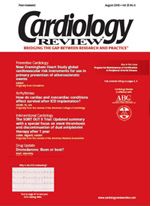Publication
Article
Cardiology Review® Online
Prehypertension triples MI risk
Hypertension
Prehypertension—a blood pressure category coined by the seventh Joint National Committee on Prevention, Detection, Evaluation, and Treatment of High Blood Pressure (JNC 7)—is associated with an increased risk of myocardial infarction (MI) and coronary artery disease (CAD) but not stroke, according to a recent analysis of data from the Framingham study. The study findings were published in Stroke (2005;36[9]:1859-1863).
JNC 7 defined prehypertension as a systolic blood pressure (SBP) of 120 to 139 mm Hg and/or a diastolic blood pressure (DBP) of 80 to 89 mm Hg. About 59 million people in the United States fit the definition of prehypertension. Normal blood pressure was defined by JNC 7 as a blood pressure less than 120/80 mm Hg, and hypertension was defined as a blood pressure of 140/90 mm Hg or greater.
To study the effect of prehypertension on the long-term risk of cardiovascular diseases, researchers led by Adnan I. Qureshi, MD, followed 5,181 participants from the Framingham study for a mean of 31 years, tallying the incidence of atherothrombotic brain infarction (ABI), all strokes, MI, and CAD.
They found that the risk of developing hypertension over the follow-up period was twice as high in those participants with prehypertension compared with normal blood pressure. To account for this variation in blood pressure status, the authors converted the data into person observations.
After adjusting for potential confounders, there was no increased risk of ABI or all strokes in prehypertensive patients compared with normotensive individuals. “This is somewhat surprising, but it may be related to the small number of stroke events in the study,” according to Dr. Qureshi, professor and director of the Cerebrovascular Program in the Zeenat Qureshi Stroke Research Center at the University of Medicine and Dentistry of New Jersey in Newark. As expected, hypertension increased the risk of ABI by 9-fold and the risk of all strokes by 7.1-fold.
The adjusted risk of MI was 3.5 times higher and the adjusted risk of CAD was 70% higher among the prehypertensive individuals compared with the normotensive ones. When stratified by gender, prehypertension was associated with significantly increased risks of MI and CAD in men but not women. Hypertension increased the risk of MI by more than seven times and the risk of CAD by more than three times.
Higher SBP was associated with an increasing risk of MI and ABI, whereas there was no relationship observed between higher DBP and the risk of MI or ABI.
The authors also examined the population-attributable risk of prehypertension, which determines the impact of eliminating this risk factor on the disease. The population-attributable risk associated with prehypertension was 47% for MI and 20% for CAD, which means that “47% of the MI in the population could be reduced by treatment of prehypertension,” write the authors. They add that this effect of prehypertension may be somewhat overestimated because cardiovascular risk factors cluster within individuals.
A previously published meta-analysis determined that vascular and overall mortality start to increase with blood pressures that exceed 115/75 mm Hg, note the authors.
The present study raises questions about the appropriate treatment of prehypertension, said Dr. Qureshi. “While we classically recommend lifestyle modifications such as weight control, regular physical activity, and changes in diet for people with prehypertension, these findings raise the question of whether we should treat prehypertensive patients more aggressively,” he said.
